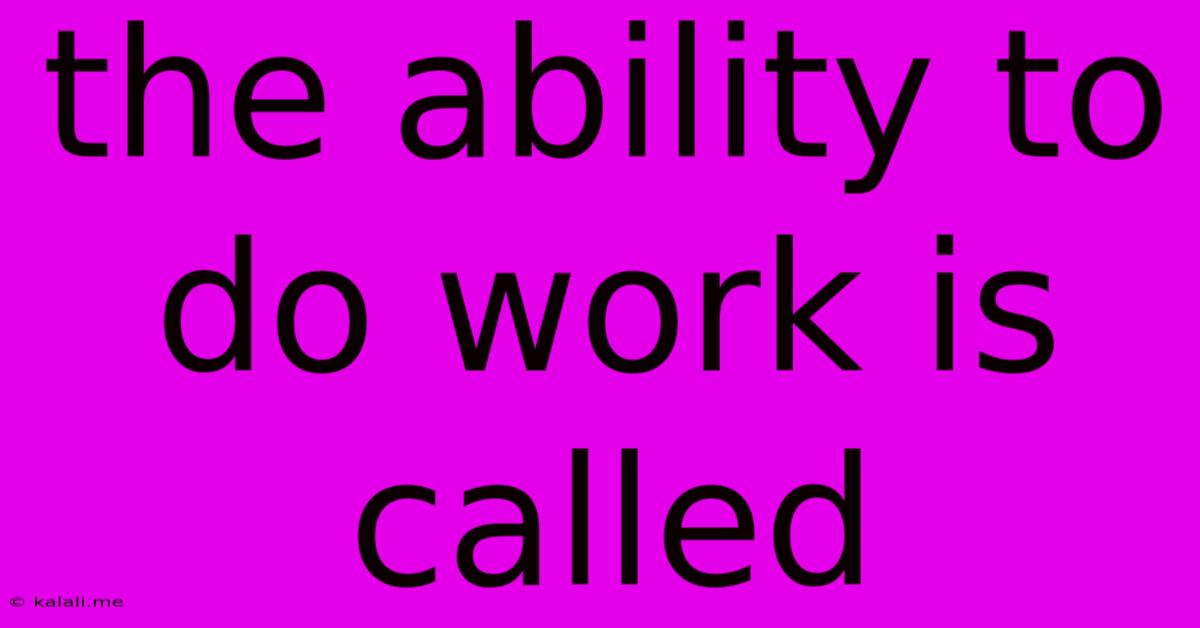The Ability To Do Work Is Called
Kalali
Jun 12, 2025 · 3 min read

Table of Contents
The Ability to Do Work: Understanding Energy and its Forms
The ability to do work is called energy. This seemingly simple definition belies a vast and complex concept fundamental to physics and our understanding of the universe. Energy isn't something you can see or touch directly, but its effects are everywhere, from the smallest atom to the largest galaxy. This article will delve into the meaning of energy, its various forms, and how it relates to the capacity for performing work.
Understanding the concept of energy is crucial in various fields, from engineering and mechanics to biology and chemistry. This makes mastering its definition and applications essential for anyone seeking a deeper understanding of the physical world. Let's explore what it truly means to possess the ability to do work.
What is Work in Physics?
Before defining energy, it's crucial to understand the precise definition of "work" in physics. It differs significantly from our everyday usage. In physics, work is done when a force causes an object to move in the direction of the force. This means simply applying a force isn't enough; the object must actually move. The amount of work done is calculated by multiplying the force applied by the distance the object moves.
Different Forms of Energy
Energy manifests itself in many forms, each capable of doing work. These include:
-
Kinetic Energy: The energy of motion. A moving car, a flying bird, or even the atoms vibrating within a material all possess kinetic energy. The faster the object moves, the greater its kinetic energy. This type of energy is directly related to the ability to perform mechanical work.
-
Potential Energy: Stored energy due to an object's position or configuration. A stretched rubber band, a book held above the ground, or water stored behind a dam all possess potential energy. This stored energy has the potential to be converted into kinetic energy and do work. Examples include gravitational potential energy (related to height) and elastic potential energy (related to stretching or compression).
-
Chemical Energy: Energy stored in the bonds between atoms and molecules. This is the energy released when we burn wood, digest food, or use batteries. It powers many biological processes and is crucial for industrial applications.
-
Thermal Energy (Heat): Energy associated with the random motion of atoms and molecules. Higher temperatures indicate greater thermal energy. This energy can be used to do work, such as heating a house or driving a steam engine.
-
Radiant Energy (Light): Energy that travels in the form of electromagnetic waves. This includes visible light, ultraviolet radiation, and X-rays. Solar panels harness radiant energy to generate electricity.
-
Nuclear Energy: Energy stored within the nucleus of an atom. This is the energy released during nuclear fission (splitting atoms) and nuclear fusion (combining atoms). Nuclear power plants utilize this energy source.
-
Electrical Energy: Energy associated with the flow of electric charge. This is the energy that powers our homes and electronic devices. It's a highly versatile and easily manipulated form of energy.
The Interchangeability of Energy
A crucial aspect of energy is its ability to transform from one form to another. This transformation is governed by the law of conservation of energy, which states that energy cannot be created or destroyed, only changed from one form to another. For example, a hydroelectric dam converts potential energy (stored water) into kinetic energy (flowing water), which is then used to generate electrical energy. Understanding this interconversion is essential for designing efficient energy systems and technologies.
Conclusion
In summary, the ability to do work is called energy. This fundamental concept is central to our understanding of the physical world, encompassing numerous forms and transformations. From the smallest subatomic particles to the largest celestial bodies, energy drives all processes and actions. Its study and harnessing continue to shape technological advancements and our understanding of the universe.
Latest Posts
Latest Posts
-
Which Of The Following Reactions Is Not A Redox Reaction
Jun 13, 2025
-
In The Third Sentence Of The First Paragraph
Jun 13, 2025
-
California Polytechnic State University Sat Scores
Jun 13, 2025
-
How Many Lakhs Is A Million
Jun 13, 2025
-
Which Of The Following Is Correctly Matched A
Jun 13, 2025
Related Post
Thank you for visiting our website which covers about The Ability To Do Work Is Called . We hope the information provided has been useful to you. Feel free to contact us if you have any questions or need further assistance. See you next time and don't miss to bookmark.